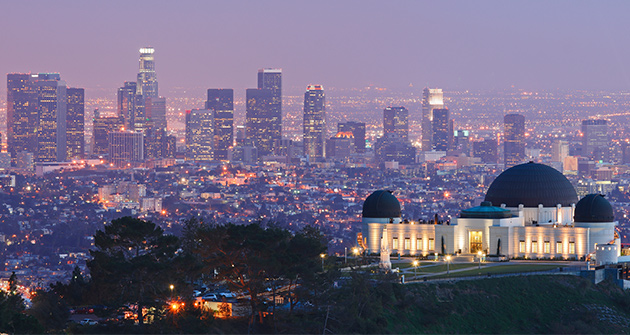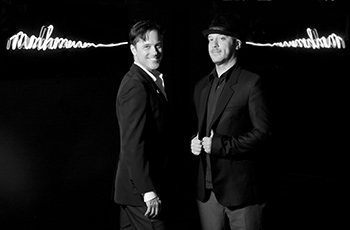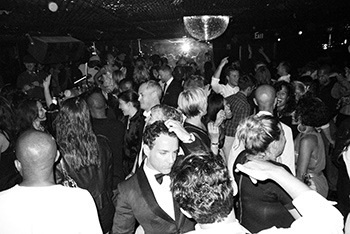
A chic, underground nightclub hidden in plain sight, Los Angeles’ Giorgio’s is the rebirth of cool. From the inside and outside of The Standard Hollywood, there are no obvious signs. First, walk in through the lobby. If you’ve made your arrangements ahead of time and the doorman grants you access, you are narrowly guided through the hotel’s cramped kitchen into a swank, dark room illuminated by the dizzying flickers of light bouncing off a disco ball. Meticulously curated by DJ and music producer Adam Michael Bravin (DJ Adam XII), the hypnotic, orchestral rhythms of 1970s disco fill the air — from Diana Ross and Chaka Khan to Chic and rarer tracks by one-hit wonders. The dance floor is always packed, and patrons only visit the black leather dressed banquettes to sip a cocktail or to catch a heady breath.
 In the past few months, this room — which only holds 85 to 100 people — has reached a tipping point. In the early days of last summer, a closed guest list and secret password gave the opening some cache as a groundswell of socialites and notables from Daphne Guinness to Tory Burch designated the place a hit. During Emmy weekend in September, Mick Jagger and P. Diddy danced the night away catapulting the hotspot into the cultural imagination. Whether a random act of the universe or zeitgeist of the current disco revival, the slow burn of Giorgio’s into a fixture on the scene has been largely due to the tireless inspiration of founding partner and nightlife promoter Bryan Rabin.
In the past few months, this room — which only holds 85 to 100 people — has reached a tipping point. In the early days of last summer, a closed guest list and secret password gave the opening some cache as a groundswell of socialites and notables from Daphne Guinness to Tory Burch designated the place a hit. During Emmy weekend in September, Mick Jagger and P. Diddy danced the night away catapulting the hotspot into the cultural imagination. Whether a random act of the universe or zeitgeist of the current disco revival, the slow burn of Giorgio’s into a fixture on the scene has been largely due to the tireless inspiration of founding partner and nightlife promoter Bryan Rabin.
Blessed with what he calls “the gift of gab,” boyish good looks, a reputation for compassion as an activist and a knack for innovating a trend at just the right time, the man the Los Angeles Times dubbed a ‘secret celebrity’ has spent the last two decades at the forefront of the nightlife in the city. A Chicago transplant, he landed in Southern California in the mid-1980s as a 16-year-old, Olympic-bound competitive figure skater sent to the West Coast for training. In 1987, an injury gave him the opportunity to explore the city’s then under-the-radar nightlife venues. At places such as Flaming Colossus and Boys & Girls, he quickly became a part of a formidable art, fashion and music scene that included creative forces such as psychologist Timothy Leary and his wife Barbara, photographer Helmut Newton, model agent Omar Alberto, fashion photographers Greg Gorman and Matthew Rolston, muse-model-actress Tania Harcourt-Cooze, singer George Michael and celebrity makeup artist Kathy Jeung. “These were glamazons,” Rabin says, still a bit awestruck. “I met many of my inspirations and many of the people who really mentored me.”
Where New York City had Andy Warhol and his iconic studio, The Factory, L.A. had pockets of cool, from Helena’s where Jack Nicholson, Sean Penn and Madonna hung out to the heavy metal haven, Cathouse. “It was about art, music, fashion, being hands on, and creating an eclectic environment,” Rabin says. “A great scene could last a really long time before anyone found out about it — which was sexier, I think.”
 Quite organically, Rabin created a cultural phenomenon when he launched legendary Cherry in 1994, historically Hollywood’s longest running nightclub. By the early 1990s, the AIDS epidemic had ravaged Los Angeles’ creative community and the 1992 riots had left citizens shell-shocked. The new venue inspired by the glam rock stylings of David Bowie and T. Rex provided an outlet. “To mix it up at that time in L.A., gay to straight to rock ’n’ roll had never been done — it was a very dangerous mix but it really resonated,” Rabin explains. “I felt people needed to laugh and have a good time again, which mirrors the feeling around Giorgio’s today.”
Quite organically, Rabin created a cultural phenomenon when he launched legendary Cherry in 1994, historically Hollywood’s longest running nightclub. By the early 1990s, the AIDS epidemic had ravaged Los Angeles’ creative community and the 1992 riots had left citizens shell-shocked. The new venue inspired by the glam rock stylings of David Bowie and T. Rex provided an outlet. “To mix it up at that time in L.A., gay to straight to rock ’n’ roll had never been done — it was a very dangerous mix but it really resonated,” Rabin explains. “I felt people needed to laugh and have a good time again, which mirrors the feeling around Giorgio’s today.”
For nine years, Cherry not only played host to the rock set, including Marilyn Manson and The Smashing Pumpkins, but was also the darling of the press. Having “said all I needed to say at that point,” Rabin retired from nightclubs at the end of 2002. For the next few years, he produced events for luxury brands such as Dior, Giorgio Armani, Vogue and The Museum of Contemporary Art, Los Angeles and Hermès as half of fête planning firm Rabin Rodgers. Then he lent his talents to the cultural movement in 2007 to inspire the vote in the campaign to elect President Barack Obama.
Fast forward to 2013, when Rabin finally answered the calls of longtime friends hotelier André Balazs and DJ Adam XII of She Wants Revenge to launch a modern disco dance club in the spirit of Nile Rodgers, on Saturday nights, named for Italian producer and ‘father of disco’ Giorgio Moroder. The room at the back of The Standard Hollywood has become the kinetic clubhouse for the likes of singer Jody Watley, John Taylor of Duran Duran, novelist Jackie Collins and David LaChapelle mixed in with L.A.’s hip crowd — all dressed up and cutting the proverbial rug. There are no telltale lines outside. People, regardless of pedigree, do sometimes get turned away. But inside you’ll find the kind of democracy that made Studio 54 the place to be in the 1970s. “Where else in L.A. are you going to have some of the wealthiest women in the country dancing next to a drag queen, dancing next to Adam Lambert, dancing next to P. Diddy, dancing next to Mick Jagger — where does that happen?” Rabin asks. “Yet it’s not about the names. It’s about that demography that’s created and all those beautiful, fabulous people that you get to meet in the night.”
The team behind Giorgio’s has big plans to expand the concept to include music compilations, a Giorgio’s style tour of national and international pop-ups and design. It’s all meant to capture the carefree spirit of disco currently dominating popular music and big in fashion next spring, with the decidedly 21st-century ethos of building a brand. “It’s been the perfect storm,” Rabin observes. “L.A. is having a huge moment again in fashion, music and art. With all of those kinds of people congregating in one city, that is a Molotov cocktail.”
Photo Courtesy of iStock and Tyler Curtis

